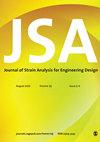采用混合DNN-SSO方法预测和改进室温下Inconel 718板材拉深工艺参数
IF 1.8
4区 工程技术
Q3 ENGINEERING, MECHANICAL
Journal of Strain Analysis for Engineering Design
Pub Date : 2023-06-23
DOI:10.1177/03093247231179006
引用次数: 0
摘要
深拉深成形技术是一种重要的金属成形工艺,但在Inconel 718板材中应用较少。本研究的主要目的是使用Inconel 718合金进行深拉深工艺。在本研究中,将厚度为1 mm的Inconel 718合金板材拉制成金属板杯,并使用选定的压边力(BHF)、毛坯直径(BD)和冲头半径(Rpn)等输入参数来控制变薄和磨损等缺陷。采用Box Behnken设计(BBD)来评估输出参数的影响。采用混合深度神经网络(DNN)对拉深过程的实验结果进行预测。在深拉深工艺中,压边力对减薄和挤压都是有利的。试验得到的最小减薄值为0.033 mm。实验时,偏耳值为2.47 mm。基于混合深度神经网络的麻雀搜索优化(DNN- sso)给出了预测模型,其预测值比RSM和非混合深度神经网络更接近实验模型。RSM、SSO-DNN、DNN等预测模型得到的最小减薄值分别为0.030、0.0304、0.023 mm。同样,预测模型得到的最小耳径分别为2.65、2.49和2.51 mm。在杂交深度神经网络中发现最小误差,疏化的平均RMSE为0.002,耳化的平均RMSE为0.0024。细化和穗化的回归系数为99%,证明了实验结果与RSM验证相吻合。本文章由计算机程序翻译,如有差异,请以英文原文为准。
Predicting and improving the novel process parameters involved in deep drawing process of Inconel 718 sheet at room temperature using hybrid DNN-SSO approach
The deep drawing technique is an important metal forming processes, and it is rarely used in the Inconel 718 sheet. The main purpose of this study is to perform a deep drawing process using the Inconel 718 alloy. In this research article, the Inconel 718 alloy sheet of 1 mm thickness is drawn into sheet metal cups, and defects such as thinning, and earing are controlled using selected input parameters such as Blank Holding Force (BHF) Blank Diameter (BD), and Punch Nose Radius (Rpn). A Box Behnken design (BBD) is used to evaluate the effects of output parameters. The hybrid Deep Neural Network (DNN) is used to predict the experimental outcomes obtained from the deep drawing process. For deep drawing process blank holding force is favorable for both thinning and earing. The minimum thinning value obtained during experimentation is 0.033 mm. During experimentation less earing value is 2.47 mm. Hybrid Deep Neural Network based Sparrow Search Optimization (DNN-SSO) gives the prediction model, where the values are much closer to the experimented model than RSM and non-Hybrid DNN. The minimum thinning obtained in the prediction model such as RSM, SSO-DNN, and DNN are 0.030, 0.0304, and 0.023 mm. Likewise, the minimum earing obtained from the predictive model is 2.65, 2.49, and 2.51 mm respectively. The minimum error is found in the hybrid DNN and the average RMSE for thinning is 0.002 and earing is 0.0024. The regression coefficient of thinning and earing is 99% which proves the experimental outcomes matches with RSM validation.
求助全文
通过发布文献求助,成功后即可免费获取论文全文。
去求助
来源期刊

Journal of Strain Analysis for Engineering Design
工程技术-材料科学:表征与测试
CiteScore
3.50
自引率
6.20%
发文量
25
审稿时长
>12 weeks
期刊介绍:
The Journal of Strain Analysis for Engineering Design provides a forum for work relating to the measurement and analysis of strain that is appropriate to engineering design and practice.
"Since launching in 1965, The Journal of Strain Analysis has been a collegiate effort, dedicated to providing exemplary service to our authors. We welcome contributions related to analytical, experimental, and numerical techniques for the analysis and/or measurement of stress and/or strain, or studies of relevant material properties and failure modes. Our international Editorial Board contains experts in all of these fields and is keen to encourage papers on novel techniques and innovative applications." Professor Eann Patterson - University of Liverpool, UK
This journal is a member of the Committee on Publication Ethics (COPE).
 求助内容:
求助内容: 应助结果提醒方式:
应助结果提醒方式:


